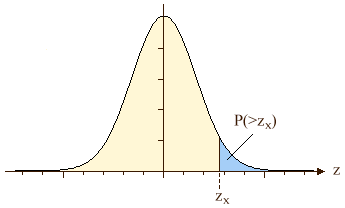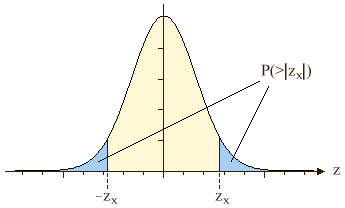 You are working with the text-only light edition of "H.Lohninger: Teach/Me Data Analysis, Springer-Verlag, Berlin-New York-Tokyo, 1999. ISBN 3-540-14743-8". Click here for further information.
You are working with the text-only light edition of "H.Lohninger: Teach/Me Data Analysis, Springer-Verlag, Berlin-New York-Tokyo, 1999. ISBN 3-540-14743-8". Click here for further information.
 You are working with the text-only light edition of "H.Lohninger: Teach/Me Data Analysis, Springer-Verlag, Berlin-New York-Tokyo, 1999. ISBN 3-540-14743-8". Click here for further information. You are working with the text-only light edition of "H.Lohninger: Teach/Me Data Analysis, Springer-Verlag, Berlin-New York-Tokyo, 1999. ISBN 3-540-14743-8". Click here for further information.
|
| See also: distributions |   |
When observing a random process, there is always a certain probability that the results are above some threshold. The probability of this threshold being exceeded is called the level of significance a.This term originates from statistical tests, where the random process is the test statistic. If the test statistic exceeds the threshold zx, the probability of making an error is a.

The shaded area of the distribution density above specifies the probability
that the outcome z of an experiment exceeds the threshold value zx.
Please note that in some cases, the interesting question may implicitly
refer to two thresholds, as shown below:

In this case, the level of significance is the sum of the areas below -zx and above +zx.
Last Update: 2004-Jul-03